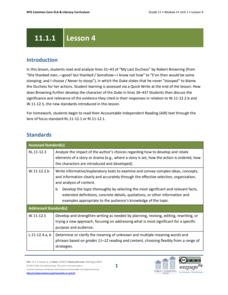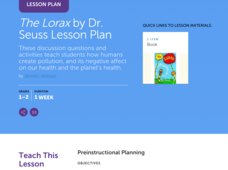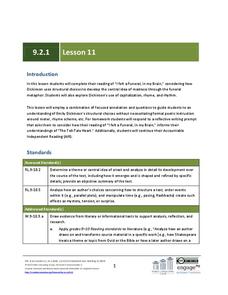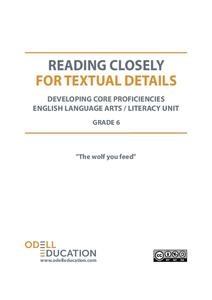Historical Thinking Matters
Spanish-American War: 3 Day Lesson
Why did the United States choose to invade Cuba in 1898? As part of a 3-day lesson, your young historians will first develop working hypotheses to answer this question, then work with a variety of historical primary source documents that...
EngageNY
Grade 9 ELA Module 3, Unit 2, Lesson 6
Having formulated a list of inquiry questions based on a reading of Temple Grandin's Animals in Translation, high schoolers complete a frame tool for their research. They categorize their questions based on preliminary research and trace...
EngageNY
Grade 10 ELA Module 4: Unit 1, Lesson 5
Learners prepare for the end-of-unit task by evaluating previous homework and writing sentences with parallel structure and various phrases. Scholars do this by closely examining E.B. White's Death of a Pig. They examine the structure of...
EngageNY
Grade 11 ELA Module 1: Unit 1, Lesson 4
Scholars analyze words Robert Browning used in My Last Duchess to give readers insight into the Duke. Pupils review homework and form groups to study lines 31-35 closely. They then respond to guided questions and complete a brief writing...
Curated OER
Homework Contract
Establish strong study habits from the beginning of the year with a contract that details good practices for completing homework. Parents and kids decide how many minutes a night should be devoted to study, and for how many weeks the...
Scholastic
Frindle Lesson Plan
"Who says a pen has to be called a pen? Why not call it a frindle?" Inspired by this quote from the award-winning novel written by Andrew Celements, this lesson allows children to invent their own...
Scholastic
The Lorax by Dr. Seuss Lesson Plan
Celebrate the whimsical world of Dr. Seuss with a lesson that features the memorable tale of The Lorax. After listening to a riveting read-aloud, scholars take part in a grand conversation about the story and environment. Then...
Poetry4kids
Simile and Metaphor Lesson Plan
Similes and metaphors are the focus of a poetry lesson complete with two exercises. Scholars read poetry excerpts, underline comparative phrases, then identify whether it contains a simile or metaphor. They then write five...
EngageNY
Grade 12 ELA Module 1, Unit 3, Lesson 2
Where to begin? This lesson plan, part of a series designed to help seniors compose a narrative response to a prompt found on the college Common Application, focuses on the techniques writers employ to craft an engaging introduction to...
New Brunswick Department of Education
Personal Development And Career Planning Curriculum Grade 9/10
What is the difference between a proactive person and a reactive person? Scholars explore the topic, and many others, with helpful lessons, discussions, role play activities, and games. Each activity supports one of the key principles...
EngageNY
Grade 5 Math Module 1, Topic E, Lesson 11
Let your understanding of multiplying decimals flourish and multiply. After briefly reviewing place value concepts and how to add and subtract decimals, scholars learn to multiply a decimal fraction (like 0.6) by a whole number. They use...
Kentucky Adult Education
Probability Lesson Plan
Roll the dice with this multimedia math instructional activity on probability. After first viewing a series of three short videos explaining probability, independent events, and dependent events, young mathematicians...
EngageNY
Grade 10 ELA Module 3: Unit 3, Lesson 1
Human tissue for sale or rent? Scholars refer back to articles they read in the previous unit and make a claim as to whether they believe it's okay to sell human tissue. Learners talk with partners, complete an outline tool, and collect...
Houghton Mifflin Harcourt
Home Sweet Home: English Language Development Lessons (Theme 5)
Through grand discussion, picture cards, and poems, enhance language proficiency with a Home Sweet Home themed unit created to support English language development. Each lesson follows a listen, speak, move, and/or look routine that...
EngageNY
Grade 9 ELA Module 2: Unit 1, Lesson 11
The capitalization rules are strict and inflexible—until you experience the fluid beauty of an Emily Dickinson poem. Ninth graders test their existing knowledge of language arts conventions with the many bent grammar rules in "I Felt a...
EngageNY
Grade 10 ELA Module 3: Unit 1, Lesson 8
Sometimes, you just need to get to the point. Scholars examine an excerpt from The Immortal Life of Henrietta Lacks, analyzing it and gathering details to determine the central idea. Completing the Surfacing Issues Tool organizer and...
Project Maths
Complex Number Operations
What do animated videos have to do with mathematics? Using operations of complex numbers and their representations on the complex plane, high schoolers observe how mathematics could be used to move animations. The activity...
EngageNY
Grade 5 Math Module 1, Topic F, Lesson 13
After completing a fluency practice set on subtracting, multiplying, and comparing decimals, pupils begin learning about dividing decimals by whole numbers. They see how to use place value reasoning to find compatible numbers for...
Savannah-Chatham County Public School System
Using Self-Control
Everyone gets frustrated from time to time. You may not be able to control the way you feel, but you can definitely learn to control the way you act in times of frustration. A helpful lesson on self control encourages your class to stop,...
ReadWriteThink
Style-Shifting: Examining and Using Formal and Informal Language Styles
Your high schoolers are probably versed in two languages: formal language, and informal conversation. Help them identify the correct language style for their audience and context with a thorough lesson and examples of different speech...
Odell Education
Reading Closely for Textual Details: Grade 6
Close reading doesn't mean to literally read text close to your face, but rather to pay attention to particular details in order to develop a deep and purposeful understanding of text. The first part of a five-part resource provides an...
Teach Engineering
Coordinates and the Cartesian Plane
The plot thickens to get a functional understanding. After a short review of plotting points on the coordinate plane, class members learn the difference between functions and relations in the second lesson in a series of nine. They...
ESL Kid Stuff
Zoo Animals
Let's go to the zoo! Take a pretend trip to the zoo with a lesson plan about animals that live at the zoo. Kids sing, match animals, practice animal sounds, and read about Sammy the Snake's birthday party.
EngageNY
The Euclidean Algorithm as an Application of the Long Division Algorithm
Individuals learn to apply the Euclidean algorithm to find the greatest common factor of two numbers. Additionally, the lesson connects greatest common factor to the largest square that can be drawn in a rectangle.























